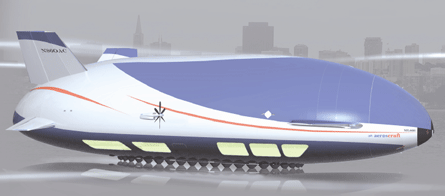Airship manufacturer Worldwide Aeros has begun development of a new type of partially buoyant air vehicle which combines dynamically managed buoyancy with aerodynamic and propulsive lift in a rigid air vehicle that can take-off and land vertically and cruise at speeds up to 120kt (220km/h).
Aeros has begun work on its first Aeroscraft, the 64m (210ft)-long ML866, as a prototype for much larger cargo vehicles capable of carrying payloads up to 60t. But the Los Angeles-based company also plans to certificate the ML866 and offer it for corporate transport and sightseeing tours applications, says chief executive Igor Pasternak.
 |
|---|
© Worldwide AerosThe "heavier than air" Aeroscraft is a prototype for much larger cargo vehicles capable of carrying payloads up to 60t |
The decision to build a prototype follows successful ground tests of the buoyancy management system, called control of structural heaviness (COSH), under the US Defense Advanced Research Projects Agency's now-terminated Walrus programme to demonstrate technology for an ultra-large, 500t-payload military transport.
The Aeroscraft is heavier than air - its partial buoyancy from helium augmented by aerodynamic lift on the rigid envelope. To make the vehicle heavier for landing and ground handling, the COSH system compresses and stores the helium. For take-off, the helium is released and the aircraft lifts off using a combination of buoyancy, air cushion, thrust vectoring and aerodynamic lift.
"The biggest difference between a hybrid airship and the Aeroscraft is that the vehicle manages its own lift depending on the stage of flight," says Pasternak. The ML866 will be able to increase its heaviness by up to 2,300kg (5,000lb), and generate up to 2,000kg of aerodynamic lift to augment its buoyancy.
Under the DARPA contract, Pasternak says, Aeros demonstrated it could build a system that would efficiently compress helium and store it in a lightweight structure. Now the company is building airborne hardware for flight testing in mid-2008 in its Aeros 40D non-rigid airship. This will demonstrate that helium can be compressed and stored in flight, he says.
Meanwhile, Aeros has begun construction of hardware for the ML866 prototype, which it hopes to fly in 2010. Static tests of the glass- and carbonfibre semi-monocoque envelope structure will begin in two months, Pasternak says, with the buoyancy management hardware to be ready in four to six months.
But Pasternak says the company will need external funds to complete the vehicle, and has begun a two-stage process to raise the financing. Aeros has also begun working with the US Federal Aviation Administration to develop the certification basis for the Aeroscraft, which is a new class of air vehicle. "We are getting a lot of support from the FAA, which is really working with us in a joint effort," he says.
The company will exhibit at September's National Business Aviation Association show in Atlanta, Georgia to solicit input from corporate customers on design of the ML866, which will provide more than 465m² (5,000ft²) of interior floorspace for use as a flying office, private "air yacht" or for carrying 12-15 passengers.
Aeros plans to offer the vehicle with a choice of vectorable turboprops, either a pair of Pratt & Whitney Canada PT6As for higher speed or lower-powered Walter M601s for greater payload. The Aeroscraft is unpressurised and has a maximum altitude of 12,000ft, and would typically operate at 6,000ft for corporate use.
Source: Flight International
















